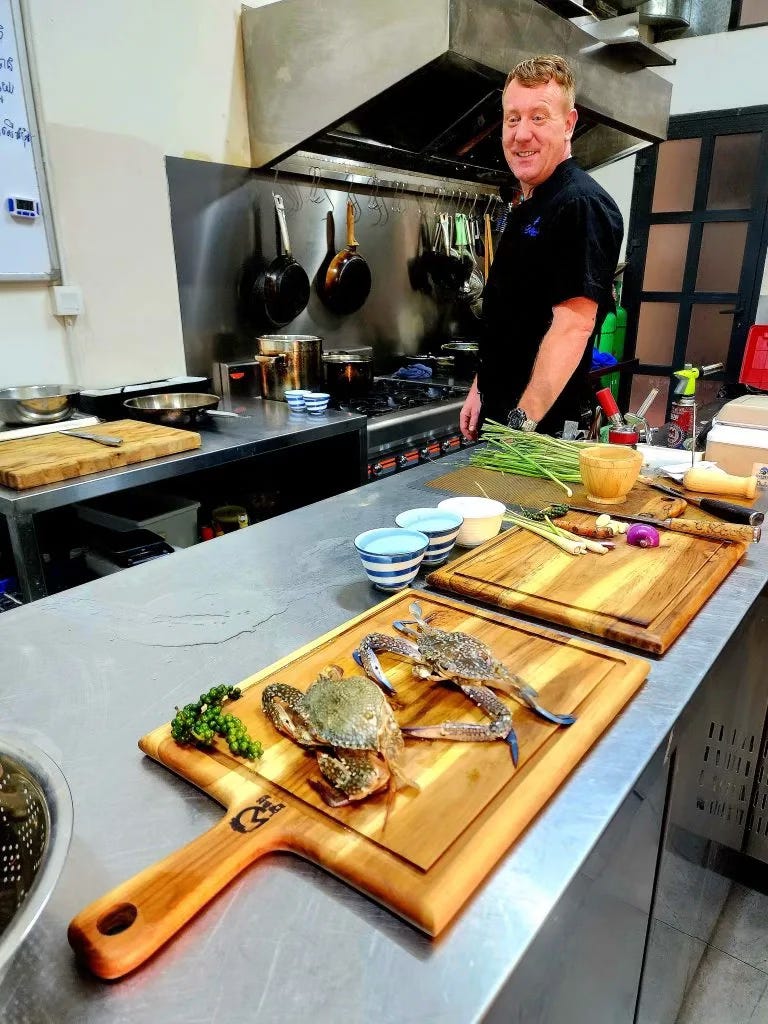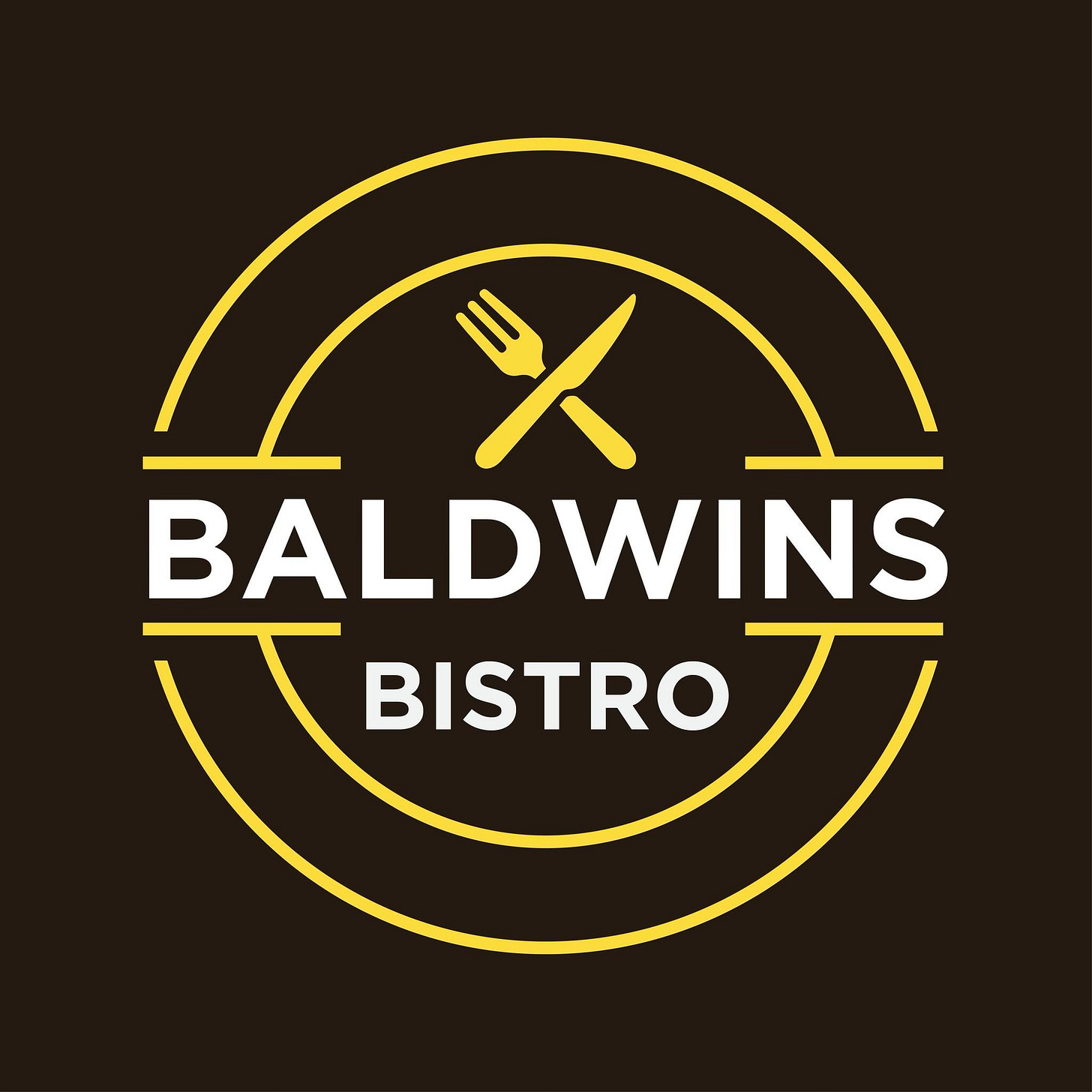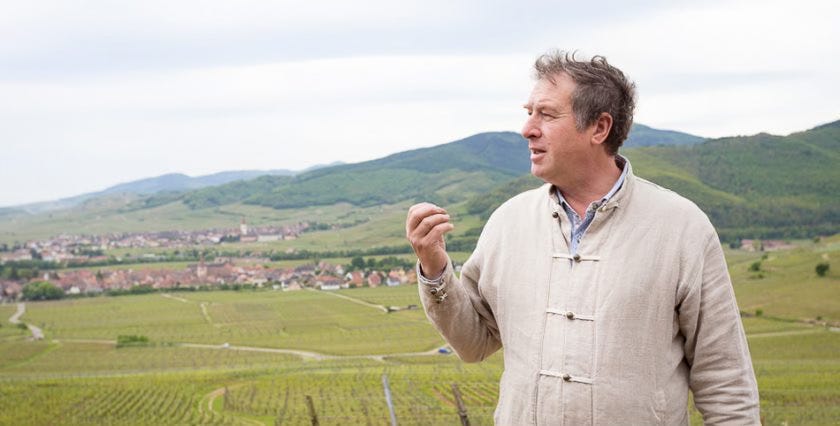A Symphony of Spice and Sweetness: Alsace Pinot Gris Meets Kep Crab Curry at Baldwin's Bistro
A recent visit to Baldwin's Bistro, the eponymous restaurant of acclaimed chef Guy Baldwin, offered a tantalising glimpse into his culinary world and a masterclass in food and wine pairing. The occasion centered around Baldwin's upcoming "Crab Fest," featuring six diverse crab preparations, but took a delicious detour with a spotlight on a remarkable Alsatian wine and a dish designed to sing alongside it.
The Wine:
Domaine Paul Blanck Wineck Schlossberg Grand Cru Pinot Gris 2017
The star of the show was a prestigious bottle: Domaine Paul Blanc's Wineck Schlossberg Grand Cru Pinot Gris from the 2017 vintage. Hailing from the steep, cool slopes of Alsace (approximately 400 meters above the Rhine River), this wine exemplified the region's signature tension. Despite its age, it retained impressive freshness. Aromatically, it was a revelation: pronounced notes of ripe apricot and lush tropical fruit promised richness. On the palate, this translated into distinct flavours of dried apricot and persimmon, delivering a definite fruity sweetness and luscious texture. Crucially, this was balanced as a "medium sweet" or "off-dry" wine. Underpinning the sweetness was a vital "powdery acidity" and distinct minerality, providing structure and lift. The finish introduced subtle floral spice notes, adding complexity. This combination of richness, controlled sweetness, vibrant acidity, and mineral backbone makes it, as described, "one of the world's great crab wines."
The Dish: Chef Baldwin's Kep Crab Curry
Responding to the challenge of pairing with this complex wine, Chef Baldwin presented a visually stunning Kep crab curry. The foundation was fresh, local crab sourced from Kep, renowned for its quality. The dish's depth came from house-made elements: a spice blend referred to as "krong" and a dedicated curry paste. This promised layers of flavour built from "many spices," though the specific blend remained a signature secret. The aromatic profile was immediately captivating and intense.
The Pairing: A Harmonious Dance
The moment of truth – combining the Alsace Grand Cru with the Khmer-inspired crab curry – proved inspired. The wine's inherent fruity sweetness and rich texture performed a perfect balancing act. It effectively "removed the heat away" from the spices in the curry, preventing any harshness or clash. Simultaneously, it allowed the "nice crab flavor" to shine through clearly, unburdened by excessive spice. Furthermore, the wine enhanced the "more sweeter elements of the curry," likely harmonizing with coconut milk or inherent sweetness from aromatics, creating a more rounded and integrated flavour experience. The host's reaction – "Wow, what a beautiful combination" – and the observation that "it works very well" underscored the success. The wine's acidity cut through the curry's richness, while its sweetness and fruit complemented both the crab and the spice profile.
A Taste of Things to Come
This exquisite pairing isn't just a one-off demonstration; it serves as a compelling preview for Baldwin's Bistro’s upcoming "Crab Fest." Chef Baldwin confirmed this very Kep crab curry will feature on the event menu, aptly named "Alsatians and Crustaceans," where each of the six crab dishes will be thoughtfully paired with wines from Alsace. The success of this specific pairing – the Domaine Paul Blanc Pinot Gris gracefully taming the heat and elevating the sweet crab and spice elements of the curry – is a powerful testament to the potential of the event. It highlights Chef Baldwin's skill in blending French technique with Khmer ingredients ("French base with some Khmer fusion") and his keen understanding of how to match bold, structured Alsace wines with the delicate richness of crustaceans. For those seeking an exceptional culinary experience, Crab Fest at Baldwin's Bistro promises an exploration of flavour, texture, and harmonious pairing.
Chef ‘Guy Baldwin’ is the British chef-owner of ‘Baldwin's Bistro’ in Phnom Penh, Cambodia, known for his innovative fusion cuisine that blends European techniques with Cambodian ingredients. Here’s a detailed overview of his culinary profile and restaurant:
👨🍳 1. Culinary Philosophy
- Baldwin champions ‘East-West fusion’, combining refined European cooking methods with vibrant Cambodian flavours and local ingredients like Kampot pepper, lemongrass, and tamarind .
- His dishes emphasize ‘cultural harmony’, as seen in creations like cured Kampot pepper salmon with citrus emulsion (starter) and slow-cooked duck leg confit with lemongrass and tamarind reduction (main) .
🍽️ 2. Signature Dishes & Menu Highlights
- Diplomatic Showcase: Prepared a prestigious two-course menu for ambassadors at the British Embassy, featuring dishes symbolising cross-cultural dialogue .
- Khmer Lobster: Fresh lobster in curried beurre blanc foam, served with coconut rice ($28), highlighting local seafood .
- Duck Leg Confit: A customer favourite, praised for its tenderness and flavor, served with celeriac purée and roasted vegetables ($14) .
- Innovative Desserts: Chocolate cigars with raspberry for celebrations and experimental creations like ‘Crab Brûlée’ (a savoury-sweet crab custard with caramelised sugar) .
🎉 3. Notable Events & Collaborations
- **Embassy Luncheon (Oct 2024)**: Hosted 12 ambassadors, using food as a tool for diplomacy .
- Crab Fest Degustation (May 2025): A multi-course crab-themed dinner paired with Alsace wines, featuring dishes like crab tartare and Kampot crab curry .
- Exclusive Private Dinners: Curated high-end experiences (e.g., Wagyu beef, Penfolds Grange wine, and Alaskan king crab) for events like Frank Baroudi’s birthday .
⭐ 4. Restaurant Ambience & Service
- Location: Street 240, Phnom Penh; modest exterior but cozy interior with art by Belgian artist Christian Develter .
- Service: Attentive staff, noted for personalised touches like complimentary warm bread and adjusting music/lighting .
- Pricing: Mid-to-high range (e.g., $12++ for a 3-course lunch special; $3.50–$35 for mains).
🏆 5. Recognition & Clientele
- Praised for “exceptional execution” in expat forums (4.5/5 ratings for food/service) .
- Attracts diplomats, expats, and gourmands seeking refined yet culturally rooted dining experiences .
Chef Baldwin’s work exemplifies how gastronomy bridges cultures, turning meals into narratives of connection. His bistro remains a culinary landmark in Phnom Penh, celebrated for both everyday excellence and avant-garde events. For reservations or updates, visit Baldwin's Bistro Facebook (https://www.facebook.com/baldwinsrestaurant/) .
Details about ‘Domaine Paul Blanck Schlossberg Grand Cru Pinot Gris 2017** are limited, but the following key insights can be pieced together from related context about the producer, vineyard, and vintage:
Producer & Vineyard
- Domaine Paul Blanck is a historic estate in Alsace's Kientzheim, practicing organic farming since the 1980s . Their Schlossberg Grand Cru vineyard—Alsace's first designated Grand Cru (1975)—features steep granite slopes, imparting minerality and structure to wines .
- Pinot Gris from Schlossberg typically expresses stone fruit, spice, and vibrant acidity due to granite soils with mica .
2017 Vintage in Alsace
- 2017 was a "goldilocks" vintage: warm summer with adequate spring rains, yielding concentrated yet balanced wines. Frost reduced yields, intensifying flavors .
- For Pinot Gris, this vintage often shows riper fruit profiles (e.g., baked apple, ginger) with moderate residual sugar (∼10–15 g/L) to balance acidity .
Wine Profile
Tasting notes for the 2017 Schlossberg Pinot Gris
- **Aroma/Flavor**: Yellow apple, stone fruit (peach/apricot), gingerbread spice, and bitter almond .
- Structure: Rich texture, medium sweetness (likely <15 g/L residual sugar), with granite-driven minerality and fresh acidity .
- Style: Fuller-bodied but poised, reflecting Blanck's terroir-focused approach .
Food Pairing & Aging
- Pairings: Complements rich dishes like roast pork, foie gras, or Asian cuisine (e.g., Crab curry) .
- Aging Potential: Grand Cru Pinot Gris from Blanck can develop honeyed complexity over 5–10 years, though 2017's balance allows early drinking.
Key Takeaways
Producer: Paul Blanck (practicing organic, historic estate)
Vineyard: Schlossberg Grand Cru (granite soils, Alsace's 1st Grand Cru)
2017 Vintage: Warm summer, balanced acidity, concentrated fruit
Taste Profile: Stone fruit, spice, medium sweetness, mineral finish
Aging Potential: 5–10 years (develops honeyed notes)
For more tasting notes or purchasing, contact Domaine Paul Blanck directly or Darren Gall.
Paul Blanck The Schlossberg Vineyard
The Schlossberg Vineyard: The Schlossberg Vineyard has long been recognized as a special terroir. The land was planted to vines before the Middle Ages. Then around 1180, Frederick Barbarossa, Emperor of the Holy Roman Empire, appropriated vineyard parcels around the Kaysersberg castle property–hence the origin of the name Schlossberg, castle mountain. The official name Schlossberg was identified as early as the 14th century. Then in 1975, Schlossberg was the first vineyard to officially become an Alsace Grand Cru site.
The 80.28 hectares of this Grand Cru sit on a very steep hillside, which requires terraced farming. South facing, its warm granite soils bring an unmistakable freshness to the wines, which are also characterized by a richly floral bouquet very present in the first years, before minerality asserts its presence after 5 to 10 years of aging. The material composing the parent rock results from metamorphosis crystallisation of migmatites (blend of gneiss and granite) and biotite granite from Kaysersberg. 76% of the vineyard is planted to Riesling, which beautifully captures the mineral potential of the granite soil.
Winemaking Notes: The Schlossberg Riesling grapes are manually harvested. Pressing is slow and gentle. Fermentation occurs spontaneously with indigenous yeast in stainless steel. The wine ages on its lees in large oak barrels for 12 months. It rests for 2-3 years further in bottle before release to the market.
Pairing Suggestions: Crab, Scallops, Oysters, Turbot, Halibut


















Share this post